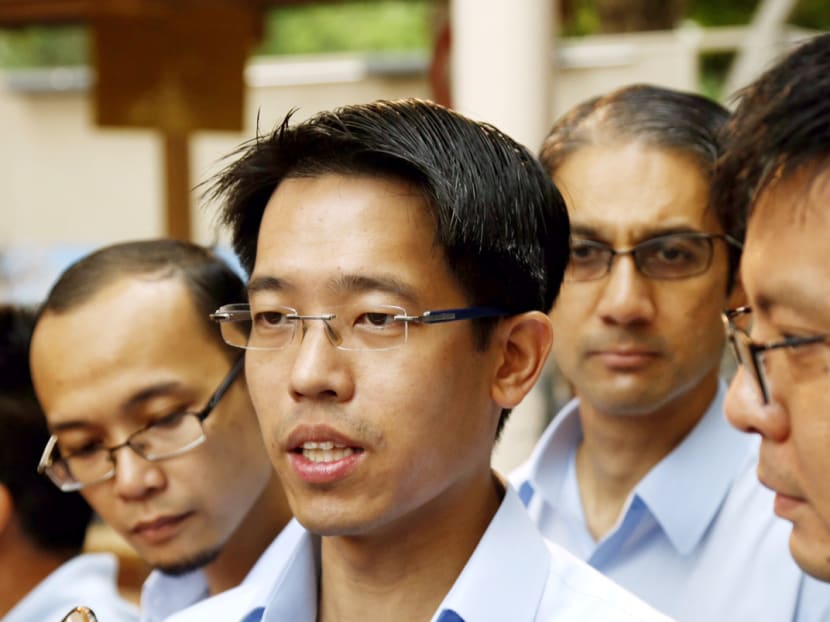S’pore has ‘no choice’ but to curb foreign worker growth
SINGAPORE— The Republic is at a point where it has “no choice” but to curb foreign workforce, as there is a need to solve the “problem” of unbridled population growth created by the ruling People’s Action Party (PAP), said the Workers’ Party’s (WP) candidates for East Coast Group Representation Constituency yesterday (Sept 8).

From left: Workers’ Party candidates Mr Fairoz Shariff, Mr Gerald Giam, Mr Leon Perera and Dr Daniel Goh. Mr Giam said that curbing foreign workforce growth is needed as Singapore faces a population growth problem 'created by the PAP'. Photo: Raj Nadarajan
SINGAPORE— The Republic is at a point where it has “no choice” but to curb foreign workforce, as there is a need to solve the “problem” of unbridled population growth created by the ruling People’s Action Party (PAP), said the Workers’ Party’s (WP) candidates for East Coast Group Representation Constituency yesterday (Sept 8).
The WP had proposed in its manifesto a policy approach focusing on the Singaporean core as the solution to population challenges. Under the policy, foreign workforce numbers would remain constant if a 1 per cent resident workforce growth target is achieved, a move to resolve a “problem earlier created by the PAP”, said WP candidate Gerald Giam during a walkabout at Simei MRT Station.
Manpower Minister Lim Swee Say said in response, however, that zero foreign manpower growth will hurt local small and medium-sized enterprises (SMEs), which account for 70 per cent of the workforce here, prompting another backlash from the WP yesterday.
Companies are bound to be hurt by “sudden policy U-turns”, said Mr Giam, but Singapore is at a point where it has “no choice” but to curb foreign workforce growth. “If we continue on this path, we are going to hit the 6.9 million or even more ... So, there is a need to take steps to resolve this problem, and there will be some pain, but the pain is not because we suddenly came up and proposed this … You need to look further back, to see what (the Government has) been planning all this time earlier on,” added Mr Giam.
Mr Leon Perera said the party is “mindful of SMEs’ needs” and has recommendations to help mitigate the effects of manpower curbs, such as keeping commercial and industrial rents predictable, auto-inclusion of smaller SMEs in assistance schemes, raising the gap for PIC grant applications and putting more focus on micro-businesses. Based on the WP’s manifesto, keeping the number of foreigner workers steady at around 1.5 million to 1.6 million would allow the country to focus on growing and upgrading the Singaporean workforce, and for a temporary addition of foreign workers to make up for shortfalls if Singapore is not able to achieve the 1 per cent target. The opposition party is also proposing investment in Singaporean workers to improve productivity, and promoting female and elderly labour workforce participation. This will result in a projected population of 5.8 million in 2030 — lower than the 6.9 million outlined in the 2013 Population White Paper, according to the WP.
Mr Giam pointed to the Government’s lax foreign manpower regime to “turbocharge the economy” in the early 2000s as the root of problems facing Singapore now. “Did they plan for the infrastructure? It seems like they have not. It seems that between the first decade of the 2000s that they did leave a lot of things to chance,” he said.
Dr Daniel Goh also asked if there is any “new calculation” given the Government’s commitment to a two-thirds Singaporean workforce. A sociologist at the National University of Singapore, Dr Goh asked whether the 6.9 million planning parameter for 2030 from the 2013 Population White Paper still stands. Building sufficient infrastructure to house a community of 6.9 million involves large costs, and may lead to “a lot of spare buffer capacity” that may lead to more immigrants just to fill up the capacity, he said.
In an interview with TODAY last month, Mr Lim had said the Government will hold fast to its goal of having a two-thirds Singaporean core in the economy, and that this will be the structure of the country’s workforce in the medium to long term.






